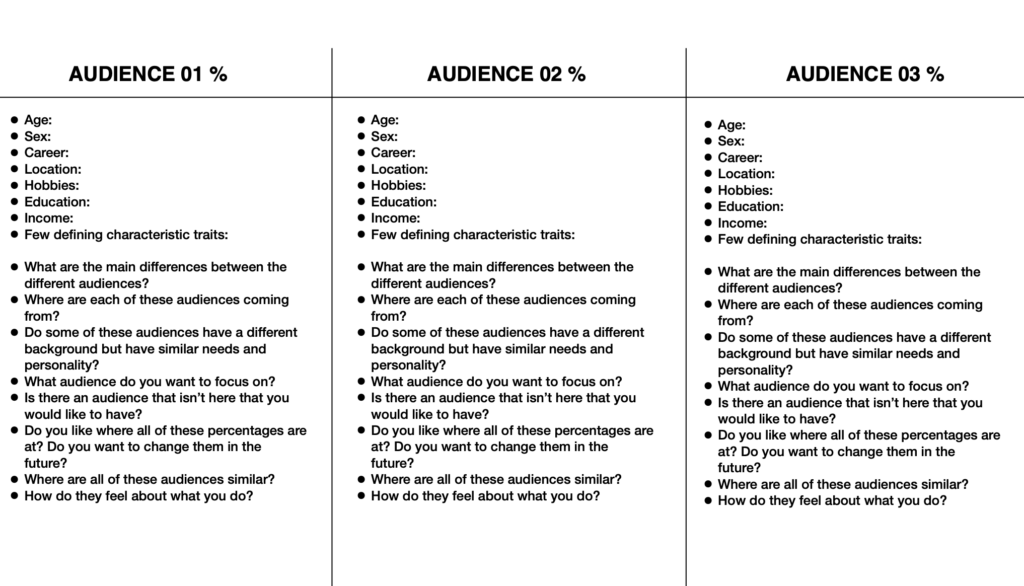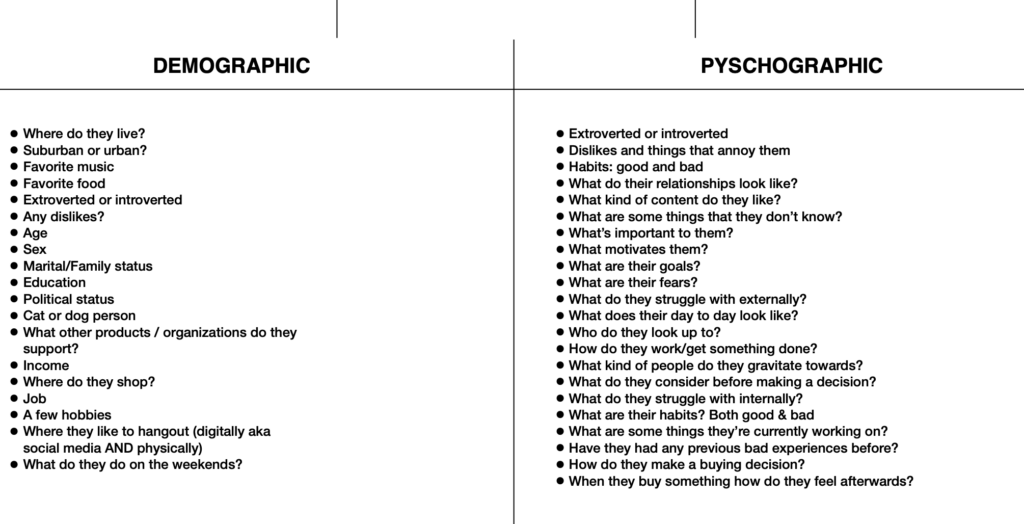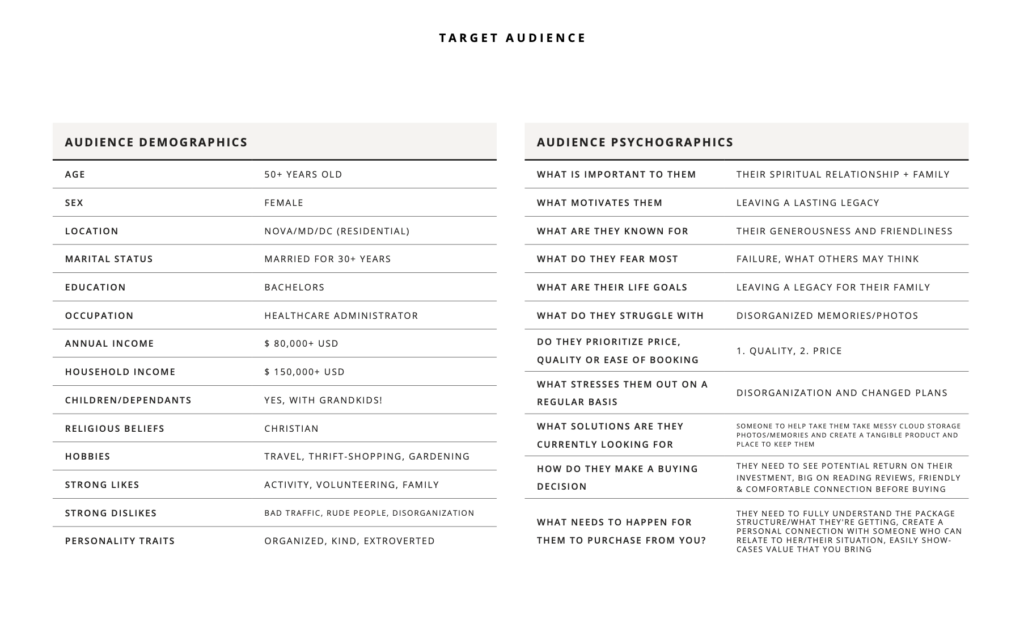Welcome to Part 2 of the Brand Strategy Summer Series! This 8-part series dives into the processes behind my Brand Strategy sessions with clients while also giving you bite-sized, actionable tips to dive into your own brand. After following along on this 8-part series, you’ll have a totally new internal and external identity by the end of the summer.
If you missed Part 1 about Brand Foundations, click this link to head to that blog post and get caught up before diving into Part 2.
Part 2 of The Brand Strategy Series is all about finding and understanding your ideal client.
In the ever-evolving world of business, one thing remains constant: knowing your audience inside-and-out is the KEY to continual success. Taking the time to not only know who you are serving, but to UNDERSTAND that audience, not only helps fine-tune your marketing strategies but also allows you to create an actual, genuine connection with the people who buy from you. People buy from businesses that they feel connected to.
In this blog post, we’re diving into the importance of defining your ideal client audience, uncovering effective audience demographics/psychographics, and ultimately crafting a consumer buying journey that speaks directly to their needs and desires.
Imagine having a group of customers who are genuinely enthusiastic about what you have to offer (the dream). Defining your ideal client is like discovering a treasure map to these eager individuals. It starts by getting to know your existing customer base and identifying those who are not only valuable, but also thoroughly satisfied with your offer. By recognizing these shared characteristics, interests, and also pain points, you can tailor your products and services to cater precisely to their needs.
Here’s a (very condensed version) on how to find and define your ideal client:
Look at your current client base and evaluate what you see – do you like serving these people? Are there attributes you don’t care for? What are their personality traits? Are they extroverted or introverted? What do they read (if anything?) Where are they hanging out outline? What problems are they having that only I can help solve? Who do I even want to work with?
When I do this exercise, I think about a client / customer that I just absolutely adored and would want to work with again. And then I use the Socrates method of asking myself “but WHY?” until I really get into the nitty gritty of it all. That will help with a little bit of the base until we dive into the demographics and psychographics of your audience.
Understanding Audience Demographics
Demographics lay the foundation for your understanding of your target audience. It’s like painting a picture of who they are. Age, gender, location, income, education – these factors give you a glimpse into their lives. I call Audience Demographics the Dating Profile because it’s extremely basic information that you find while scrolling on dating apps (#iykyk).
By analyzing this information, you can uncover patterns and trends that shape your marketing strategies. From social media campaigns to personalized content, demographics provide the compass for reaching the right people at the right time.
Actionable tip: use answerthepublic.com

Exploring Audience Psychographics
While demographics provide a surface-level understanding, psychographics plunge deeper into the realm of your audience’s desires, values, and aspirations. Think of it as deciphering the unique code that unlocks their motivations. I call Psychographics the First Date – we already covered the basics of this person via the dating profile (the demographics), but the first date is the chance when you ask them deeper questions, getting to really know them as a person.
By exploring your “date’s” lifestyle, interests, attitudes, and values, you gain insights into their decision-making process and how they perceive your brand. Armed with this knowledge, you can create messages and experiences that resonate with them on a profound level.
Below are a few screenshots that I use during a brand strategy session*. You can see that while the powerpoint itself is a disorganized brain-dump, it is organized into those two different sections of the dating profile v the first date. These are key questions I like to ask my clients about their audience in order to do more research.
*Keynote slides are from the 10KGG/BMM courses by Carli Anna. I could not have gotten to where I am without either of these courses (shameless plug!!)

Eventually, I’ll compile both the demographic and psychographic research into the beautiful PDF that you see below! My brand strategy session PDFs are about 40+ pages and dive into a little more than what you see below, but this is a good taste of it for now.

Actionable tip: if you’re struggling with what problems your audience may be having, the best thing to do is some market research! Interview 3-5 ‘ideal’ clients using the following questions:
- If I could waive a magic wand and solve one problem for you what would it be?
- If you were to describe my brand in three words what would it be?
- What do you struggle with the most when it comes to [relation to your service]? (planning your wedding, creating a website, deciding on a hairstylist, etc.)
- What’s standing in the way between where you are and where you want to be?
Creating a Consumer Buying Journey:
Now that you have the map and the code, it’s time to embark on a journey together with your ideal clients. This journey is all about guiding them from initial awareness to a long-lasting relationship. Along the way, there are multiple touchpoints and stages to navigate, each requiring a tailored approach.
a. Awareness: Picture the moment when your ideal client first discovers your brand. Your goal is to captivate their attention and make an unforgettable first impression. How will your client/consumer know about you and what you offer? Where will they find out about you? Through which platforms/mediums?
b. Consideration: As they dive deeper into their research, your audience is weighing their options. This is your chance to showcase your expertise and establish trust. Your consumer is researching more info about who you are & what you do. How can you build trust at this point and move them to the next stage? Offer valuable content, testimonials, case studies, and personalized communication to guide them toward considering your brand as the top choice.
Actionable tip: This is a common stage to struggle with, although each stage has it’s own headaches. If you visit answerthepublic.com, it can give you vital information on what you could start covering through marketing and social media tactics.
c. Purchase: The moment of truth has arrived. Your ideal client is ready to make a decision. Make it as easy and enticing as possible. Offer incentives, highlight your unique value proposition, and provide a seamless purchasing experience that solidifies their choice. How can your client/consumer book you or purchase from you? Is the process simple and straight forward or is there something holding them back?
d. Retention: The journey doesn’t end with a transaction. In fact, it’s just the beginning. Focus on delivering exceptional customer service, support, and memorable post-purchase experiences. Encourage feedback, nurture relationships, and turn satisfied customers into brand advocates. What can you do to retain the client/consumer and get them to purchase or work with you again? What, when and how can you pitch them another offer?
e. Advocacy: How can you continue to nurture this relationship and develop brand loyalty to increase your client/ consumer lifetime value?
Building a successful business begins with fully understanding your ideal client audience. By defining who they are, exploring their demographics and psychographics, and crafting a journey tailored to their exact needs, you can forge meaningful connections and cultivate a loyal customer base. This means RAVING FANS that not only buy from you, but that cultivate referrals for you (eventually bringing in more cha-chinggg into that bank account). I can’t wait to hear about how defining your ideal client audience and their needs is going to affect how you market, attract, and sell your products or services!
And just remember, as we are all humans and continue evolving, so will our audience and ideal client. There is no shame in redefining your ideal audience. In fact, I suggest that you reevaluate your audience at least once a year through a brand audit.






Comments +